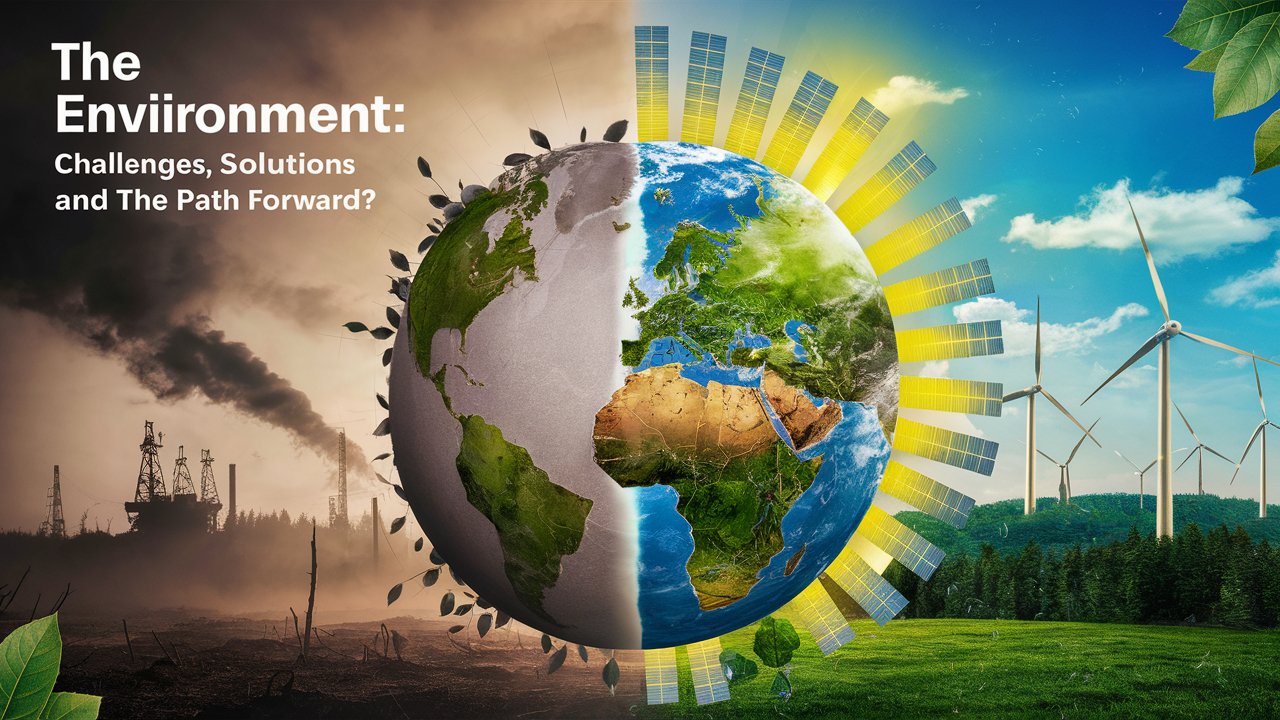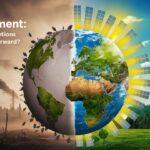The environment, our planet’s life support system, faces unprecedented challenges. From climate change to deforestation, pollution, and biodiversity loss, the environmental crises we confront today are vast and complex. As the impact of human activities on the Earth intensifies, the urgency to address these issues has never been greater. This blog will explore the current state of the environment, the challenges we face, the solutions available, and the path forward toward a sustainable future.
Introduction: Understanding Our Environmental Crisis
The Earth’s environment is a delicate balance of ecosystems, climate, and natural resources that support life. However, this balance has been disrupted by human activities, leading to significant environmental challenges. The rapid industrialization, urbanization, and population growth of the last century have placed immense pressure on natural systems, resulting in severe consequences for the planet and its inhabitants.
Key Environmental Issues:
- Climate Change: The rise in global temperatures due to greenhouse gas emissions, leading to extreme weather events, sea-level rise, and changes in ecosystems.
- Deforestation: The large-scale removal of forests for agriculture, logging, and urban development, leading to habitat loss, biodiversity decline, and disruption of the carbon cycle.
- Pollution: The contamination of air, water, and soil with harmful substances, affecting human health, wildlife, and ecosystems.
- Biodiversity Loss: The extinction of species and the degradation of ecosystems, driven by habitat destruction, pollution, and climate change.
These challenges are interconnected, with each exacerbating the others. For instance, deforestation contributes to climate change by reducing the Earth’s capacity to absorb carbon dioxide, while climate change accelerates the loss of biodiversity by altering habitats.
Climate Change: The Defining Issue of Our Time
Climate change is arguably the most pressing environmental issue of the 21st century. It is primarily driven by the increase in greenhouse gases, such as carbon dioxide (CO2) and methane (CH4), which trap heat in the Earth’s atmosphere. This phenomenon, known as the greenhouse effect, is causing global temperatures to rise at an alarming rate.
Impacts of Climate Change:
- Rising Temperatures: Global temperatures have risen by approximately 1.2°C since the pre-industrial era. This increase is already having severe consequences, including more frequent and intense heatwaves, droughts, and wildfires.
- Melting Ice and Rising Sea Levels: The polar ice caps and glaciers are melting at unprecedented rates, contributing to rising sea levels. This threatens coastal communities with flooding, erosion, and the loss of habitat.
- Extreme Weather Events: Climate change is increasing the frequency and severity of extreme weather events, such as hurricanes, typhoons, and heavy rainfall. These events can lead to devastating impacts on communities, infrastructure, and ecosystems.
- Ocean Acidification: The oceans absorb about a quarter of the CO2 emitted by human activities, leading to acidification. This process harms marine life, particularly organisms with calcium carbonate shells or skeletons, such as corals and shellfish.
- Disruption of Ecosystems: As temperatures rise, many species are forced to migrate to cooler areas, leading to shifts in ecosystems. Some species may not be able to adapt quickly enough, resulting in population declines or extinction.
Mitigating Climate Change:
Addressing climate change requires a multi-faceted approach, focusing on reducing greenhouse gas emissions and enhancing resilience to its impacts.
- Transition to Renewable Energy: Moving away from fossil fuels and adopting renewable energy sources, such as solar, wind, and hydroelectric power, is crucial to reducing CO2 emissions.
- Energy Efficiency: Improving energy efficiency in industries, transportation, and buildings can significantly reduce greenhouse gas emissions.
- Reforestation and Afforestation: Protecting existing forests and planting new trees can help absorb CO2 from the atmosphere, acting as a natural carbon sink.
- Carbon Pricing: Implementing carbon pricing mechanisms, such as carbon taxes or cap-and-trade systems, can incentivize businesses and individuals to reduce their carbon footprint.
- Climate Adaptation: Building resilience to the impacts of climate change through infrastructure improvements, disaster preparedness, and ecosystem restoration is essential for protecting vulnerable communities.
Deforestation: The Destruction of Our Forests
Forests cover approximately 31% of the Earth’s land area and are vital to maintaining ecological balance. They provide habitat for countless species, regulate the climate by absorbing CO2, and support the livelihoods of millions of people. However, deforestation continues at an alarming rate, driven by agricultural expansion, logging, and infrastructure development.
Causes of Deforestation:
- Agricultural Expansion: The conversion of forests into agricultural land, particularly for cattle ranching, palm oil plantations, and soy production, is the leading cause of deforestation.
- Logging: The demand for timber and wood products leads to large-scale logging operations, often in sensitive and biodiverse areas.
- Infrastructure Development: The construction of roads, dams, and urban areas encroaches on forested regions, leading to habitat fragmentation and deforestation.
- Mining: Extractive industries, such as mining for minerals and fossil fuels, often require the clearing of vast forest areas.
Consequences of Deforestation:
- Loss of Biodiversity: Forests are home to a significant proportion of the world’s species. Deforestation leads to habitat loss and fragmentation, threatening the survival of many plants and animals.
- Climate Change: Forests act as carbon sinks, absorbing CO2 from the atmosphere. When they are destroyed, not only is this carbon-absorbing capacity lost, but the carbon stored in trees is also released into the atmosphere, contributing to climate change.
- Disruption of Water Cycles: Forests play a critical role in regulating the water cycle, influencing precipitation patterns and maintaining water quality. Deforestation can lead to changes in local and regional climates, as well as increased risk of floods and droughts.
- Impact on Indigenous Communities: Many indigenous peoples depend on forests for their livelihoods and cultural identity. Deforestation threatens their way of life and can lead to displacement and loss of traditional knowledge.
Solutions to Deforestation:
- Sustainable Forestry: Implementing sustainable forestry practices, such as selective logging and reduced-impact logging, can minimize the environmental impact of timber extraction.
- Agroforestry: Integrating trees into agricultural systems, known as agroforestry, can enhance biodiversity, improve soil health, and provide additional income for farmers.
- Protected Areas: Establishing and enforcing protected areas can prevent deforestation in critical regions, preserving biodiversity and maintaining ecosystem services.
- Reforestation and Afforestation: Replanting trees in deforested areas and restoring degraded forests can help recover lost ecosystems and sequester carbon.
- Consumer Awareness: Encouraging consumers to choose products certified by sustainable forestry standards, such as the Forest Stewardship Council (FSC), can reduce the demand for products linked to deforestation.
Pollution: A Threat to Human Health and the Environment
Pollution, the contamination of the environment with harmful substances, poses significant risks to human health, wildlife, and ecosystems. The main types of pollution include air pollution, water pollution, and soil contamination.
Air Pollution:
Air pollution is caused by the release of pollutants into the atmosphere, primarily from the burning of fossil fuels, industrial processes, and vehicle emissions. Common air pollutants include particulate matter (PM), nitrogen oxides (NOx), sulfur dioxide (SO2), and volatile organic compounds (VOCs).
Impacts of Air Pollution:
- Human Health: Air pollution is linked to respiratory and cardiovascular diseases, including asthma, chronic obstructive pulmonary disease (COPD), and lung cancer. It is also a significant contributor to premature deaths worldwide.
- Climate Change: Some air pollutants, such as black carbon and methane, are potent greenhouse gases that contribute to global warming.
- Ecosystem Damage: Air pollution can lead to acid rain, which harms forests, lakes, and soils, and can cause the decline of sensitive species.
Water Pollution:
Water pollution occurs when harmful substances, such as chemicals, waste, and pathogens, enter water bodies, contaminating freshwater and marine ecosystems. Sources of water pollution include industrial discharges, agricultural runoff, sewage, and plastic waste.
Impacts of Water Pollution:
- Human Health: Contaminated water can spread waterborne diseases, such as cholera and dysentery, and expose people to toxic substances, such as heavy metals and pesticides.
- Marine Life: Pollution can devastate marine ecosystems, leading to the death of fish, coral reefs, and other aquatic life. Plastic pollution, in particular, poses a significant threat to marine species, as they can ingest or become entangled in plastic debris.
- Eutrophication: Nutrient pollution from agricultural runoff can cause eutrophication, a process that depletes oxygen in water bodies, leading to the death of aquatic life and the creation of “dead zones.”
Soil Contamination:
Soil contamination occurs when hazardous substances, such as chemicals, heavy metals, and pesticides, accumulate in the soil, degrading its quality and affecting plant and animal life. This contamination often results from industrial activities, waste disposal, and agricultural practices.
Impacts of Soil Contamination:
- Crop Health: Contaminated soil can reduce crop yields and affect the quality of food, leading to food insecurity and health risks for consumers.
- Ecosystem Degradation: Soil contamination can disrupt soil ecosystems, affecting the organisms that live in the soil and the plants that grow in it.
- Water Pollution: Contaminants in the soil can leach into groundwater, further exacerbating water pollution and posing risks to drinking water supplies.
Solutions to Pollution:
- Emission Controls: Implementing stricter emission controls for industries





